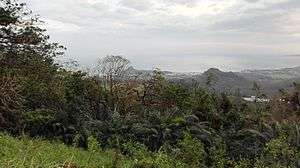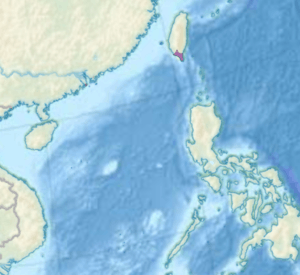South Taiwan monsoon rain forests
The South Taiwan monsoon rain forests ecoregion (WWF ID:IM0171) covers the southern tip of Taiwan, 200 km east of the mainland. The area is one of high biodiversity, due to its location between temperate and subtropical zones, its monsoon exposure, and its high altitude variation (from mangrove forests at sea level to inland mountains).[2][3]
| South Taiwan monsoon rain forests | |
|---|---|
 View in Kenting National Park | |
 Ecoregion territory (in purple) | |
| Ecology | |
| Realm | Indomalayan realm |
| Biome | tropical and subtropical moist broadleaf forests |
| Borders | Taiwan subtropical evergreen forests |
| Geography | |
| Area | 2,590 km2 (1,000 sq mi) |
| Country | Taiwan |
| Coordinates | 22°30′N 120°45′E |
| Conservation | |
| Protected | 349 km2 (135 sq mi) (14%)[1] |
Location and description
The ecoregion covers only the southernmost 60 km of the island, 70 km west to east at its widest. The central ridge is mountainous, with a flat coastal flat on the northwest. The ecoregion is only 1,000 square miles in area. Much of the southern tip of the island is protected by Kenting National Park. It is bounded on the north by the Taiwan subtropical evergreen forests ecoregion.
Climate
The climate of the ecoregion is Dry-winter humid subtropical climate (Köppen climate classification (Cwa)). This climate is characterized as having no month averaging below 0 °C (32 °F), at least one month averaging above 22 °C (72 °F), and four months averaging over 10 °C (50 °F). Precipitation in the wet summer months is ten time or more the average of the winter months.[4][5]
Flora and fauna
The inland mountains support forests of both evergreen and deciduous trees. The evergreens include Chinese banyan (Ficus microcarpa) and Chinese cryptocarya (Cryptocarya chinensis); deciduous trees include Kapok (Bombax ceiba). The coastal mangrove forests feature the Asiatic mangrove (Rhizophora mucronata) and Black mangrove (Bruguiera gymnorhiza).[2] The coastal areas support migratory birds on the East Asian–Australasian Flyway.
Conservation
A 2017 assessment found that 349 km², or 14%, of the ecoregion is in protected areas. Another 68% is forested but outside protected areas.[6]
See also
References
- Eric Dinerstein, David Olson, et al. (2017). An Ecoregion-Based Approach to Protecting Half the Terrestrial Realm, BioScience, Volume 67, Issue 6, June 2017, Pages 534–545; Supplemental material 2 table S1b.
- "South Taiwan monsoon rain forests". World Wildlife Federation. Retrieved March 9, 2020.
- "Map of Ecoregions 2017". Resolve, using WWF data. Retrieved September 14, 2019.
- Kottek, M., J. Grieser, C. Beck, B. Rudolf, and F. Rubel, 2006. "World Map of Koppen-Geiger Climate Classification Updated" (PDF). Gebrüder Borntraeger 2006. Retrieved September 14, 2019.CS1 maint: multiple names: authors list (link)
- "Dataset - Koppen climate classifications". World Bank. Retrieved September 14, 2019.
- Eric Dinerstein, David Olson, et al. (2017). An Ecoregion-Based Approach to Protecting Half the Terrestrial Realm, BioScience, Volume 67, Issue 6, June 2017, Pages 534–545; Supplemental material 2 table S1b.